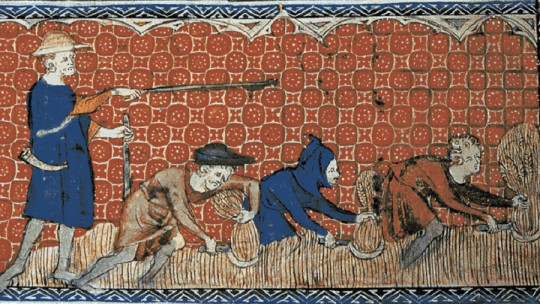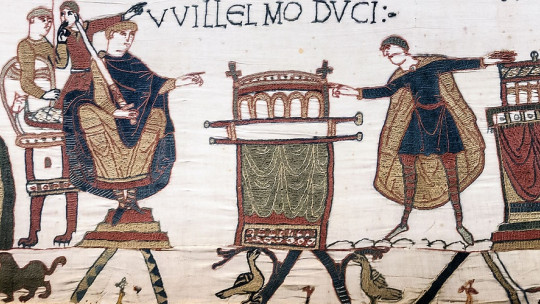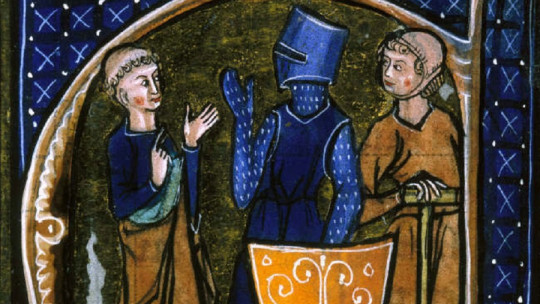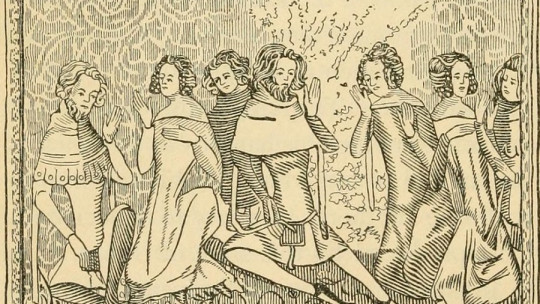Although feudalism is related to the Middle Ages in general, it is not true that this was the main regime of this entire historical period. Because although the feudal system acquired great prominence during the central centuries of the Middle Ages, in its last stage it was a system in decline, the object of multiple criticisms and which was in the crosshairs of peasant revolutions, which tried to improve their conditions.
The feudal system was based mainly on a self-sufficiency economy. Its setting is basically rural and is closely linked to the consolidation of medieval lordships, to the detriment of the cities and, therefore, the state. In this article we will review the characteristics of feudalism and what it was based on. the feudal economy
The feudal economy as the driving force of the Middle Ages
It was, as we have already said, one of the main medieval regimes, which defined an entire era. You cannot understand the economy of the first centuries of the Middle Ages without understanding the functioning of this system. Let’s see, then, what it consists of.
What is feudalism?
Before starting to talk about the feudal economy, we must be clear about the concept of feudalism. So what do we mean by feudalism?
Feudalism is the political, economic and social regime that developed in Europe during much of the Middle Ages We say “large part” because, in reality, during the thousand years that this historical period lasted, very diverse circumstances occurred that resulted in important and constant changes in the economic and social structure of Europe. Historians tend to distinguish two stages within medieval feudalism: the so-called first feudalism or Carolingian feudalism and classical or full feudalism.
During Carolingian feudalism (8th – 11th centuries, approximately) The foundations are laid for what will be this medieval regime, spurred by the change that the transition from a public type state (the Roman state) to a conglomerate of private states meant for Europe. The Carolingian Empire had a lot to do with the emergence and subsequent crystallization of the feudal regime, as we will see in the next point.
Classic or full feudalism (11th – 13th centuries) It is the consolidation of this system that has been shaped during previous centuries. Europe is, therefore, configured as a mosaic of private territories, that is, they are the heritage of a family. Broadly speaking, we can say that feudalism has the following characteristics:
Thus, in this brief summary of what feudalism is, we see the main differences between this medieval regime and the idea of the state: while, in the latter, the idea of the “common good” prevails and there is a centralized power that administers the resources, in classic feudalism each fiefdom is an independent territory, with its own laws, its own military body (the lord’s knights) and its own economic system.
The origin of feudalism
The causes of the birth of feudalism are very complex. However, broadly speaking we can affirm that This medieval regime is the son of the dismemberment of the Roman Empire and the war situation that Europe experienced during the 7th and 9th centuries. Let’s see it below.
The end of the Roman state
If we have to give an example that exemplifies the concept of “state”, it would be Rome. Indeed; We have a strong central government, established in a capital, which distributes state officials throughout the empire’s territories. These territories are not the property of a specific individual or family, but belong to the Roman state; that is, to all citizens. Each of these citizens must contribute economically and militarily to the maintenance of the state and, in return, it will administer the assets collected (in theory) in the most beneficial way for all citizens.
As we see, our current models of state drink directly from this Roman concept of res publica or “public thing”
During the last years of the Roman Empire things began to change. Already during the 3rd century AD, a series of ephemeral powers intermittently took the reins of various regions of the empire.
Later, in 395, during the reign of Emperor Theodosius, the final division between the Western Roman Empire and the Eastern Roman Empire took place. This division represented the first crack in the unity of the state which, in the following years, would only increase. Because the invasions of the “barbarian” peoples had already begun: at the end of the 4th century, the Goths penetrated the Italian peninsula, and the Huns, led by their fearsome king, Attila, penetrated the Roman territories of the West with blood and fire. .
To alleviate this political instability, the Roman government establishes pacts with some of the invading peoples. The most important was the one that agreed with the Visigoths who received land (foedus) in exchange for serving the empire militarily. This is the germ of what, centuries later, would be feudalism: the obtaining of land and food in exchange for fidelity and military service to the lord.
A world at war
Before the final fall of Roman rule in the West, it had been observed an atomization of the different territories that made up the empire The small towns and villages saw that Rome was no longer the strong state that could protect them from invasions and, therefore, they decided to become more or less independent territories. With the definitive breakup of the empire and the disappearance of the Roman state, these territories gained autonomy and sufficiency.
In any case, in the centuries immediately following the fall of the Western Roman Empire we cannot, of course, speak of feudalization. Because the territories that make up the barbarian peoples settled in Europe still retain the character of “public property”; that is, they are still states. We are referring, of course, to the Visigoth kingdom of Toulouse, first, and that of Toledo, later; and, above all, to the powerful kingdom of the Franks.
The Franks built a state model based on the concept of res publica Roman During the time of Charlemagne we find a network of officials extended to all corners of the Frankish (or Carolingian) Empire, as well as a central government, personified in the figure of the emperor, from which the imperial territories were administered. The still present central power is evident in the figure of the missi dominici, special envoys of the emperor whose mission was, precisely, to control imperial officials. These officials, the counts and the marquises, were mainly found in the border areas, the so-called marks. Europe was, in the centuries after the fall of Rome, an unstable territory. During the 6th century, the Avars, Slavs, and Bulgarians made serious inroads into Europe; And to this new threat we had to add, obviously, the Muslim invasions that, starting in the 7th century, put all of Western Europe in check.
The Europe post-roman So it was a world at war Thus, the so-called “warlords” began to proliferate: gradually, these counts and marquises settled in the Marches, who had been sent by the Frankish emperor with the mission of controlling the borders, and whose power was strictly temporary, began to claim ownership of those same lands that had been entrusted to them. Little by little, the position was passed from father to son and, in this way, the private possession of those lands, which had once been public, of the state was reinforced.
Finally, in 877, the Capitulations of Querzy legalized what, de facto, had been practiced for years. From then on, the lands would be hereditary and their ownership would pass from parents to children. In other words: it was no longer the state that administered these territories, but rather they became part of the heritage of the local family. Feudalism was born.
The feudal economy: autonomy and self-sufficiency
The feudalization of Europe led to a return to the rural economy Obviously, if the power of the state no longer existed, if each territory had a private character and was the possession of the family that administered it, there was no longer a power to regularize large-scale trade and exchange. In the same way, the instability produced by the continuous invasions (the Muslim invasions of the 7th century would be added, one hundred years later, by the Viking invasions) had as a consequence the strengthening of local military forces that could face the threats, without counting with no outside help.
Small land holdings then proliferated, administered by the feudal lord. The main workforce in these territories were the peasants; In exchange for constant and continuous work, the lord allowed them to settle in the place and they were assigned a manso or farm so that the peasant’s family could have the basics to survive.
The payment that the peasant owed his lord in exchange for this means of, we could call, survival, was his own work in the so-called terra indominicata , the stately reserve. This work, called corveas in free territory and Opera and labors In Hispanic territory, it could last up to three days a week.
In addition, a series of tributes could also be paid in exchange for using the common parts of the fief, such as the mill, roads, bridges, etc., known by the curious name of banalities. The lord was, therefore, the true master of all the elements that were within his jurisdiction, so the use of each of them entailed the payment of a use tax. In fact, even the manses or farms awarded to the peasants belonged to the lord, so what the peasants owned was nothing more than usufruct.
On the other hand, Peasants were also subject to paying certain taxes, which could be in kind or in cash The most common thing in the early years of feudalism, and given the limited circulation of currency, was for taxes to be paid in the form of bags of wheat, animals or any other agricultural product. It was also common for peasants to perform services in the manor castle, services that gradually decreased and were replaced, starting in the 12th century, by the work of day laborers.
In summary, we have territories cultivated by peasants who produce for the lord (payment of taxes in kind, work from the lord’s reserve) and for themselves. Therefore, the economy of the fiefdoms was entirely circular and absolutely self-enclosed.
The peasants: serfs and settlers
It is common to find the word “servant” in texts referring to feudalism, referring to the peasants of the manor territories. However, Not all the peasants who worked the land were serfs
The free families that settled in the territory, based on an agreement with the lord, were the colonists. These peasants were not subject to the same obligations as serfs, and enjoyed greater freedom. For their part, the serfs were former manumitted slaves who had lost their status as “objects” but who, however, retained certain servile obligations towards their lord. The legal regimes of both were not, therefore, identical.
In any case, and whether as settlers or serfs, these peasants were men in their own right, a condition that was far from that of slaves of ancient times, subject to complete reification.
In such a heavily ruralized world, the village was the main population center With the disappearance of the state and the rise of feudalism, the cities lost all their political importance, and simply became the seat of the bishop. It will not be until the 11th century, with the resurgence of commercial activity, that the towns will once again be at the economic forefront.
The economic boom arrives
During full feudalism, a series of technical innovations occurred that allowed a significant increase in productivity.
Thus, water mills proliferated as a driving force, coming from northern Europe, and irrigation ditches brought by the Muslims.
But, probably, one of the improvements that had the greatest impact on the increase in production is increasing the traction capacity of draft animals , which was achieved through the use of several innovative elements, among which the front yoke used on oxen stands out. Thus, through this seemingly simple tool, greater dragging capacity was achieved, which allowed a considerable increase in agricultural production.
Greater production implies the generation of surplus, and surpluses mean the possibility of trade. Indeed, this is what happened from the 11th century onwards, when trade was reborn in Europe. And, with the reactivation of commerce, cities are reborn and, with them, a new society emerges that no longer has anything to do with the old feudal Europe of previous centuries.









